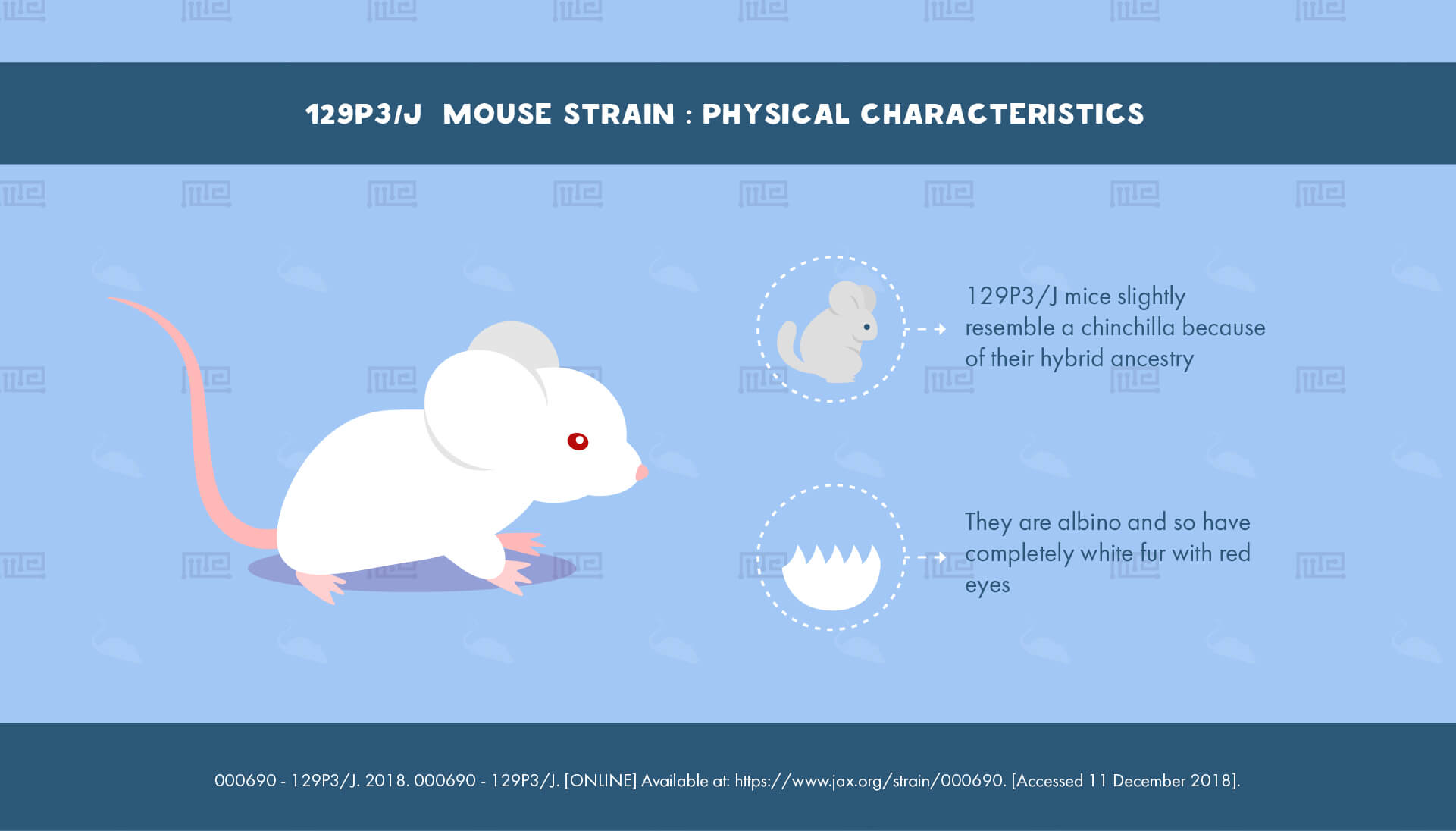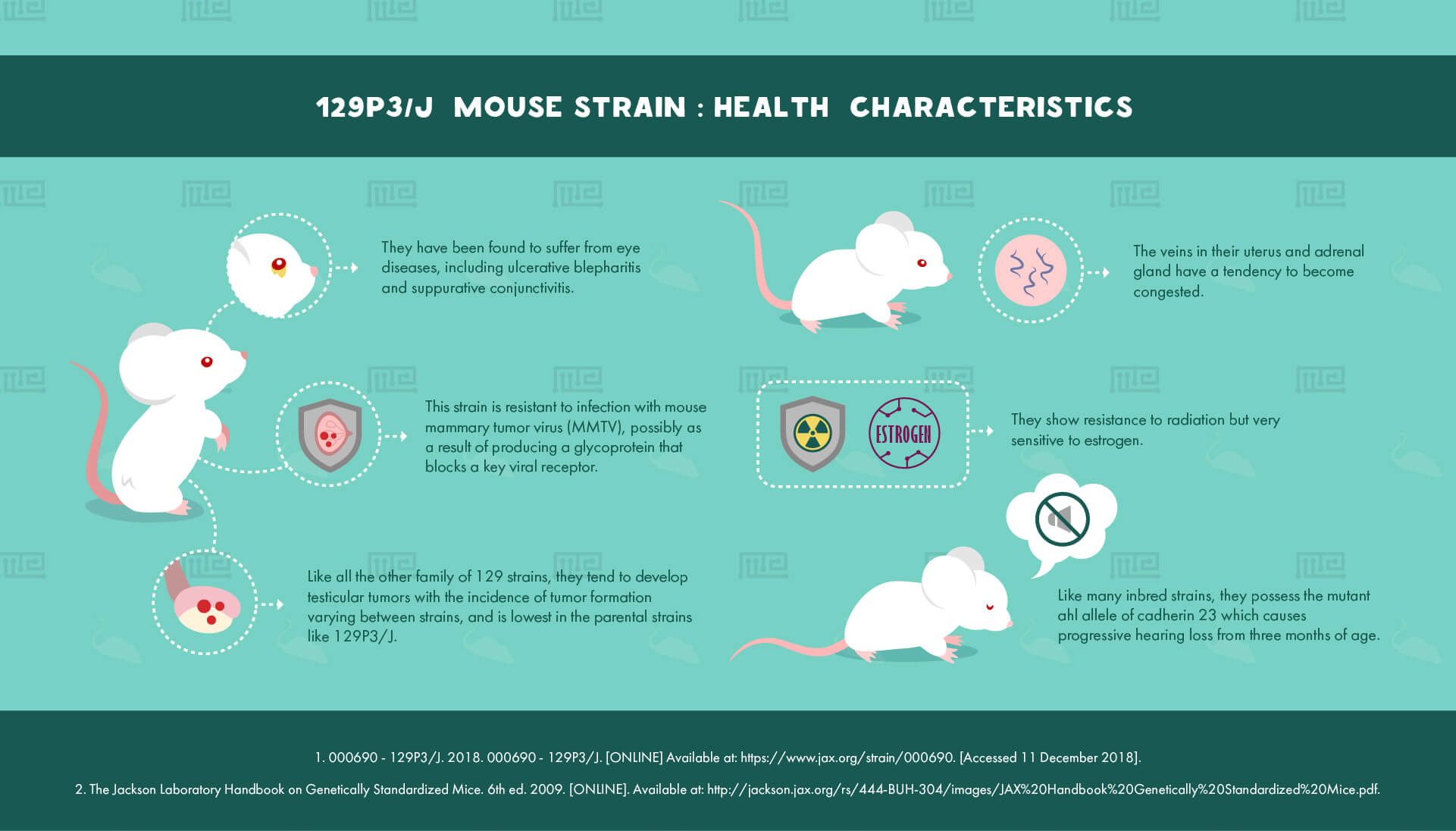Overview
129P3/J is an inbred strain of mouse that is one of the “parental” strains within the 129 family.[1]
History
The 129 family is descended from a cross between mice (English fanciers) and a chinchilla stock carried out by Dunn in 1928. Stocks of these passed from the Jackson Laboratory to outside laboratories and then back again several times over the course of the twentieth century.[2]
In 1997, Simpson divided the 129 strains into three main groups according to their tumor incidence: parental, “steel” and “ter”. 129P3/J was known as 129/J until its recognition as part of the parental grouping in 2004 when its name was changed to the current one.[1][3]
Physical Characteristics
129P3/J mice, like all mice of the 129 family, bear a slight resemblance to a chinchilla on account of their hybrid ancestry. They are albino and so have completely white fur with red eyes.[1]
Behavioral Characteristics & Handling
Mice of the 129P3/J strain are described as “very nervous” and “jumpy”, but also as “gentle”.[3] This mixed assessment suggests that while these mice do not display aggression, their anxiety will make them difficult to capture and hold, and so researchers requiring the utmost ease in handling may want to choose another strain.
The Jackson Laboratory caution that while these mice have decently sized litters, they are poor breeders and often do not look after their infants well. Around half of their offspring are stillborn or die very young, and many are chewed, eaten or lose limbs. Loud noises can initiate this behavior, and so the mice should be kept in a quiet environment.[3]
129P3/J mice show a lower preference for sweet tasting substances than C57BL/6J, which may indicate anhedonia and a depression-like phenotype.[4] Another result consistent with depression is seen in a study involving 129X1/SvJ, 129P3/J and C57BL/6J, where 129P3/J showed the least spontaneous activity in the home cage and open field test. The performance of 129P3/J in the elevated zero maze is comparable to 129X1/SvJ i.e. showing elevated anxiety compared to C57BL/6J.[5]
Health Characteristics
The major health characteristic of mice from the 129 family of strains is their tendency to develop testicular tumors. The incidence of tumor formation varies between strains and is lowest in the parental strains such as 129P3/J.[1]
Sources disagree about the exact tumor incidence in this strain: in one source, the Jackson Laboratory claim 1-3%,[1] but in another, they claim 5%.[3] This strain is also resistant to infection with mouse mammary tumor virus (MMTV), possibly owing to its production of a glycoprotein that blocks a key viral receptor.[1]
129P3/J mice have been found to suffer from eye diseases, including ulcerative blepharitis and suppurative conjunctivitis. Corynebacterium has been associated with their conjunctivitis, an unusual observation only made with this strain and BALB/c.[3]
Veins in their uterus and adrenal gland have a tendency to become congested. They are resistant to radiation but very sensitive to estrogen. Also, like many inbred strains, they possess the mutant ahl allele of cadherin 23 that confers progressive hearing loss from three months of age.[3]
Major Experimental Uses
This strain is mainly of interest in cancer research, especially when used in tandem with other strains of the 129 family that have different tumor incidence. They are also frequently used for studies involving ovary transplant or ova transfer.
References
- 000690 – 129P3/J. 2018. 000690 – 129P3/J. [ONLINE] Available at: https://www.jax.org/strain/000690. [Accessed 11 December 2018].
- MGI – Inbred Strains: 129. 2018. MGI – Inbred Strains: 129. [ONLINE] Available at: http://www.informatics.jax.org/inbred_strains/mouse/docs/129.shtml. [Accessed 11 December 2018].
- The Jackson Laboratory Handbook on Genetically Standardized Mice. 6th ed. 2009. [ONLINE]. Available at: http://jackson.jax.org/rs/444-BUH-304/images/JAX%20Handbook%20Genetically%20Standardized%20Mice.pdf.
- Bachmanov, A. A., Tordoff, M. G., & Beauchamp, G. K. 2001. Sweetener preference of C57BL/6ByJ and 129P3/J mice. Chemical senses. 26(7), 905-13.
- Xiangdong Tang, Larry D. Sanford. Home cage activity and activity-based measures of anxiety in 129P3/J, 129X1/SvJ and C57BL/6J mice. Physiology & Behavior. 84. 2005. 105–115.


